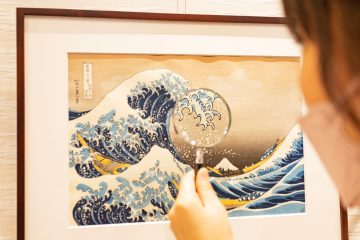SPECIAL
My First Osaka
From Kire & Hirano, Osaka – Part 1:
The Way of Tea & The Way of Calligraphy by a Russian Monk

2023.11.17
Hello! I’m Nasu from South Korea. I love Japan and have studied the Japanese language by watching Japanese TV shows on YouTube. Now I am doing a Working Holiday in Japan, working at a hotel in Namba.
Many guests at the hotel ask me about where to get a hands-on Japanese cultural experience. Today, I went to a temple to try it myself and experienced the Japanese tea ceremony and calligraphy with my friend, Ji won, who’s also here from South Korea for Working Holiday.

Nasu

Ji won
A Russian Buddhist Priest


Heading south on Osaka Metro’s Tanimachi Line, you come across a station with a very unique name. It’s so unusual that even the Japanese have difficulty decoding the Kanji characters of Kire-Uriwari Station (喜連瓜破駅). In about 10 minutes of walk from this uniquely named station is Nyoganji Temple.
I was told the Deputy Chief Priest of Nyoganji Temple is originally from Russia. As a fellow non-Japanese native, I felt closer to him already. Interestingly, in person, Rev. Volkogonov was graceful and modest, possessing the qualities I often find in Japanese people.

Founded by Prince Shotoku and reconstructed by Kobo Daishi, the prestigious Nyoanji Temple has a long history and offers an opportunity to experience traditional Japanese culture such as Sado (the way of tea), Shakyo (hand copying Buddhist sutra) and Shabutsu (tracing the images of Buddha), Shodo (the way of calligraphy), and ceramic art.
We tried the tea ceremony (fun for beginners) and calligraphy (popular among international visitors)!
The Way of Tea


We were shown to the Shoin Room (study) where we sat in seiza-style, sitting back on our heels with our legs folded under our thighs on the floor—same as Vajrasana if you’re familiar with yoga.
Reverend is fluent in Russian, Japanese, and English and can talk to you in any of these languages. We asked him to speak in Japanese as my Japanese is better than my English, and Ji won also preferred it since she’s learning the language.

No worries if you don’t want/are unable to sit seiza-style by the way. They have chairs. We were given the choice first and decided to give seiza a try although we weren’t too confident we’d last.

Seasons are important in the way of tea and are expressed in various places around the room—in the scroll on the wall, in the flower arrangement, and even in the design of the tea bowls.
What I thought of as mere decorations had more meaning to them than I’d thought.

The concept of Wabi-sabi, an ancient Japanese philosophy that is closely related to the way of tea, was new to me but the Reverend explained it in a way that was easy to understand.
In short, Wabi-sabi is a Japanese aesthetic, an appreciation for the simple beauty that exists in transience and imperfection.

Not many words are spoken at a tea ceremony, but there is communication, a spiritual exchange, between the master, Rev. Volkogonov in this case, and us guests.
Your social status and titles on your business cards are irrelevant here. People gather on equal grounds and enjoy the special space, what they see and hear—the aroma, the flavor, the warmth of the tea—using all five senses. The way of tea is a philosophy and art in itself.
Tea & Sweets


It’s time for tea.

When a bowl of tea is served in front of you, you pick it up, not too high from the floor, and, using both hands, bring it closer to just in front of your knees.
Then, with the tea still on the floor, you quietly greet with a slight bow “Osaki-ni Itadakimasu” (I’m going to have the tea first) to the person to your left, then bow to the master while declaring that you’re going to have the tea, “Otemae Chodai Itashimasu”.
I learned each movement is an expression of compassion and thoughtfulness for others.

Traditional Japanese sweets called Wagashi are usually served before the tea at the tea ceremony. The cute little pink Wagashi we had was created in the image of Cosmos, a flower of the season. It had a refined beauty. I didn’t want to eat it.
We also experienced making tea in the end. Reverend was nice to us beginners and showed us each step. I was a little nervous about making the tea with a bamboo tea whisk, and creating the foam on top of the tea was a bit tricky, but it wasn’t too hard after all♪

It was a different, and nice way to enjoy tea. I realized how much I was into the art of tea when I was done. I tried to get up and… My legs had fallen asleep!
I’m not used to seiza-style, and it was my first time to feel my legs numb. I had lots of first-time experiences in one day!
The Way of Calligraphy


We tried calligraphy next. Ji won had learned it recently from an elderly friend, but I hadn’t held a brush since I was in elementary school! I had no confidence I could do it💦

We began with learning about the posture and how to hold the brush, then practiced writing horizontal lines with help from the Reverend. Rest the brush on the paper and bring it upright. Slide it across while releasing the tension slowly, then press it down a little in the end…
We also practiced writing vertical lines then wrote the Kanji character for a person, “人”. It requires only two strokes, but there’s a lot into it in calligraphy. I wasn’t sure if I was doing it right but Ji won was quickly improving her skills next to me.

After some practice, we both chose a Kanji character and wrote it neatly on a Shikishi board, handmade art paper with a hard paperboard backing. Ji won wrote 奥 and I chose 勇.

Writing on a Shikishi board felt a bit more “official” but my writing became a nice art piece to put up somewhere, or to give to someone as a gift. Either way, it’s a nice memento to remember this cultural experience.
My takeaway from the experience, as Rev. Volkogonov put it: “If you keep writing even just a little bit, you will improve your skills without fail. When you put your heart into something, the end product will carry your message.”

Ji won and I had a great time, a fulfilling experience, at Nyoganji Temple. Every day, we walk the streets of a very busy city, but this experience taught me the importance of a calm, quiet life.

The cost of the hour-long cultural experience at Nyoganji Temple is 2,000 yen (incl. Tax) per person for the Way of Tea as well as the Way of Calligraphy. Nyoganji Temple also offers an opportunity to experience other Japanese cultural activities like Shakyo and Shabutsu as well as ceramic art.
You can make a reservation on their homepage and you can talk to them in English to secure this wonderful cultural experience for you and your travel companions!
And be on the lookout for the next article–I will tell you about our exploration of the cool town of Hirano and where to grab tasty udon noodle lunch in the area!
Spots Introduced
Nyoganji Temple
[Access] About 7 mins walk from Exit 3 at Kire-Uriwari Station on the Tanimachi Line.
Recommended Plans

Inside Osaka Expo with Sean Ep. 1: Monster
Hunter, Sweets & More
Have you been to the Osaka Expo yet? I'm Sean. I'm a student currently …
2025.07.04

The World of Ukiyo-e:
Japonism that Captured the World
In 17th to 19th century Japan, after the turbulent and violent Warring States period ended, …
2025.06.27

An epic appearance of the Milky Way in Osaka!!
A guide to a magical night on Tanabata, July 7.
Tanabata, aka the Star Festival, is one of the traditional seasonal festivals of Japan, …
2025.06.13






